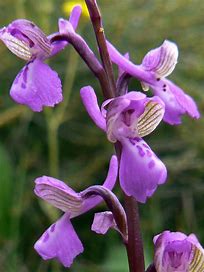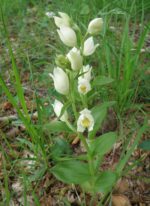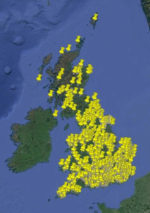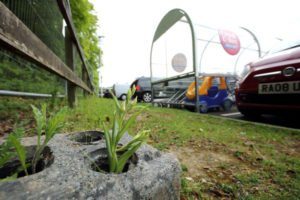
Can Citizen Scientists Make a Difference (for orchids)?
Yes, we can! Ordinary people all over the world are participating in conservation efforts to protect natural habitats. A recent article in The Guardian by Fiona Gell, a marine biologist, tells of one such project.
In the article entitled “Who’s driving the future of conservation? Ordinary people”, Gell relates how more than 8,000 people showed up on the beaches of the Isle of Man to participate in regular weekend beach cleanups. As a result, the work of these volunteers solidified the island’s status as a UNESCO Biosphere Reserve, a classification shared by the Galapagos and Yellowstone.

Cephalanthera Damasonium
Could something like the Isle of Man project happen closer to home? It surely can. I (Charles) have been fascinated ever since learning in my 2015 Master Naturalist training that for the last 20 years, local bird enthusiasts have counted and logged on-line their bird sightings during a 3-day period each February here in the U.S. The information gathered by these citizen scientists goes into an extensive database which then is analyzed by scientists to better understand trends in bird populations, ranges, and shifts in migration patterns.
Because my major interest lies with orchids, I was very happy to learn that the Hexalectris populations in Dallas are surveyed each year as a citizen scientist project.
While we have not achieved the astonishing level of participation cited in the Guardian article (10% of the population!) we do have citizen scientists from our local orchid society (GNTOS), as well as the local Master Naturalists chapter, who are willing to brave the Texas heat to complete these annual Hexalectris surveys. Perhaps, if more people became aware of these citizen scientist projects they would volunteer to join up and help.
But, is it really possible to get ten percent of orchid lovers interested in becoming Citizen Scientists? Well, why not? If the Brits can do it, we can, too!

Sightings for British project
Just think, from April 2015 to August 2016, over 2000 people covered the U.K. documenting, photographing, and logging their orchid sightings as part of the Natural History Museum’s Orchid Observers Project.
According to the website, the project had the goal of determining questions in two areas:
- Climate Science research: Are orchid flowering times being affected by climate change? (This is called phenology)
- Social science research: How do volunteers interact and share ideas and knowledge with one another, within a project that combines both outdoor and online activities? (This was of interest by the funding entity: the museum’s Arts and Humanities Research Council.)
Volunteers were able to access a guide to the 56 native species of orchids that bloom between April and September, very much like the one published by the Smithsonian’s North American Orchid Conservation Center “Go Orchid” site, which covers more than 200 North American species. The British guide helped the volunteers three important ways: First, to identify the plants they found; second, by providing guidelines of most likely places where orchids could be found; and finally, the current protection status of each native species.
The Museum’s blog has a summary of the result of the survey itself:
- more than 2,000 volunteers taking part
- more than 1,800 new observations of wild orchids
- as many as 200 new locations, where particular species of orchid hadn’t been recorded before
- 50,948 classifications on the Orchid Observers online platform
- orchid photographs taken all over the UK, from the Shetland Islands in the far north, to the Isles of Scilly in the far southwest.
A valuable feature of a citizen scientist project of this size is that it can cover more territory in a very short time than can mere handfuls of botanists over the decades. As an added bonus, it is always encouraging to discover new and previously unknown populations of the rare or endangered species.
Two unexpected results of the British survey: The Orchid Observers Volunteers discovered and photographed both the green-winged orchid (Anacamptis morio), as well as the white helleborine (Cephalanthera damasonium) in several previously unknown locations. Both of these orchids are currently classified as ‘near threatened’ and ‘vulnerable’ to extinction in the UK respectively.
To answer the question of blooming times, the blooming data collected in the year-long survey was compared to the thousands of herbarium samples on hand at facilities like the U.K.’s Botanical Society of Britain and Ireland (BSBI), whose collections contain over 15,000 samples collected over three centuries.
Not to be outdone by the U.K., we have similar assets in our own country, such as the Botanical Research Institute of Texas (BRIT) in Fort Worth, and the American Orchid Society’s own historic Harvard collections.
The British Natural History Museum’s blog (no date given) gives us an initial look at findings to date:
We are about to start the full analysis of the data, but an initial scoping study has been completed for one species, the green-winged orchid (Anacamptis morio). This analysis combined the flowering time data extracted from historical Museum specimens with recent biological records from the BSBI’s database and the 2015 Orchid Observers field observations.Initial results show that the median date of last year’s flowering was at least 10 days earlier than that shown in the Museum data (which mainly covers the years 1830 to 1970). We can also see that peak flowering time for this species advances by just over four days for every 1-degree Celsius rise in mean February to April temperature.
Initial indications are that different orchid species may differ significantly in their response to climate change, something that we look forward to investigating in more detail. These preliminary results should of course be treated with care, however, they are certainly very promising!
Can citizen scientists make a difference? Yes, absolutely, and more are needed to help in these efforts. There is so much yet to be discovered, and it must be done quickly, while our native orchid species still exist.

White helleborine
This will take a monumental effort. But it is an effort that can be both enjoyable and rewarding. Participants have a rare opportunity to experience nature at a primary level. And there is a lot to be said for the friendships that can be formed by working together with like-minded people, on a project dear to our hearts.
Citizen scientists will indeed be our key to future understanding of our planet and particularly, our friends, the orchids. Of equal importance may be the trend to bring citizens closer to nature instilling is us an increased appreciation of the beauty and importance of our gifts of nature. Only by participating can we ensure the survival of species and the conservation of habitats they need to thrive.
![]()